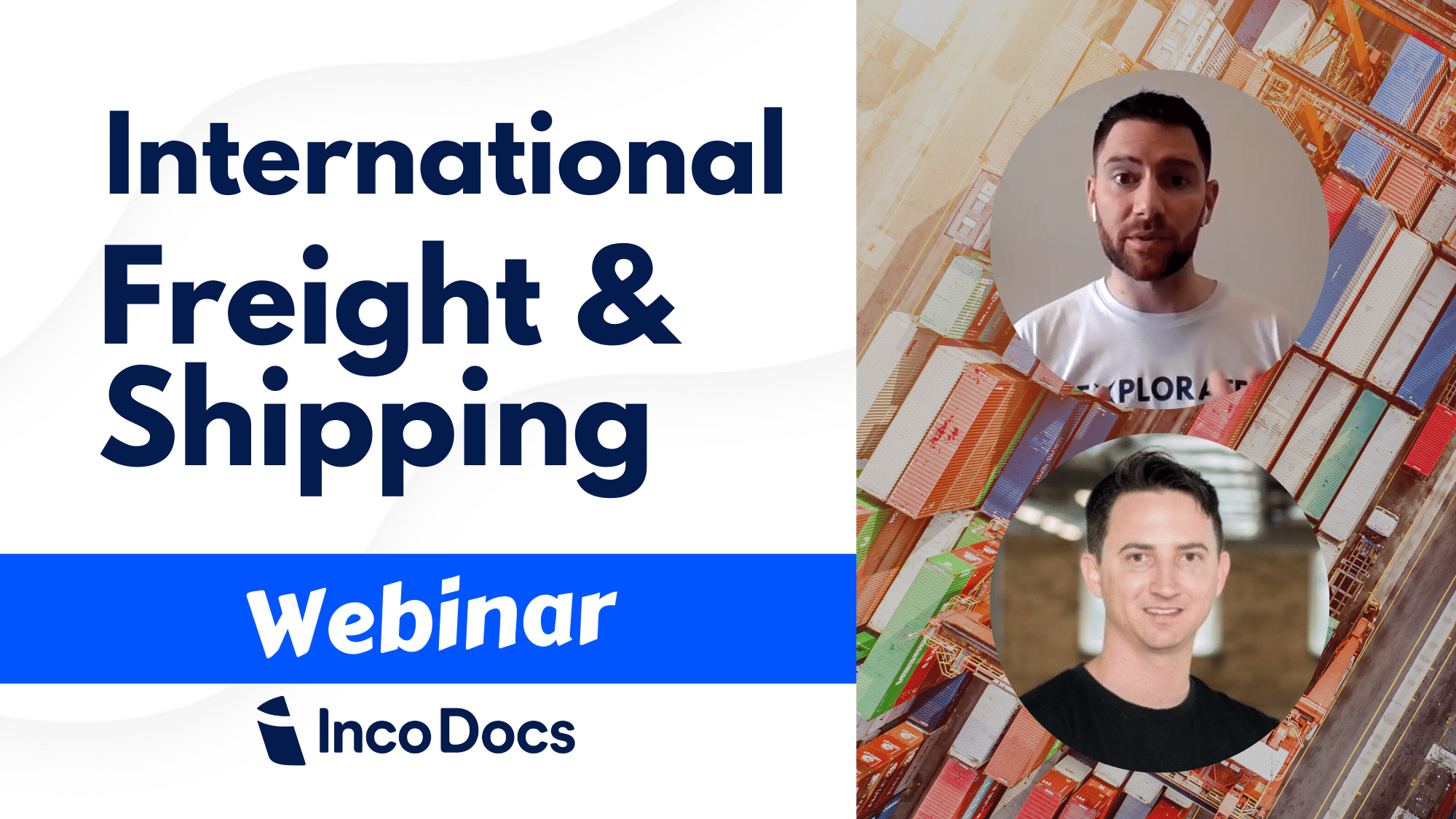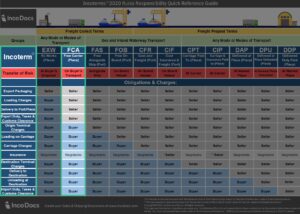The Import Export Podcast
Conor from Explorate gives an overview of how the shipping process currently works and we discuss how the industry is beginning to change through software. We give shippers tips on how to improve their supply chain and logistics withing their business using readily available software.
Topics Covered:
- What is the current process that shippers go through to make a booking for their shipments?
- Why are freight forwarder’s rates, quotes and invoices so confusing?
- Are there any freight forwarders or tech companies that are making the quote and invoicing process clearer and easier to understand?
- How does Explorate work, as a user how do I make a booking for my shipment?
- What are some key things that importers or exporters can change to improve their processes?
- What are some examples of software that shippers can instantly use to improve their supply chain?
- How do you see the shipment booking process in 5 years from now?
Listen to Podcast:
Watch Webinar:
Are you working on innovative solutions for the Supply Chain? Contact us for Media partnership opportunities.
Contact UsRead full Transcript here:
Ben: 0:00:05.01
Hi, everybody. It’s Ben Thompson here from IncoDocs.com and welcome to the Import Export podcast. Today, we’re talking about “International Freight and Shipping” and we’re joined by Conor Hagan from Explorate. Conor, thanks for joining us today.
Conor: 0:00:17.19
Great to be here, Ben.
Ben: 0:00:19.06
Today, Conor and I want to discuss international freight and shipping, how it currently works, and what companies are doing to improve that manual booking process. Before we get started today, Conor, tell me a bit about yourself and the experience you’ve had in this industry.
Conor: 0:00:36.22
Yeah. No problem, Ben. I’ve been in the industry for 15 years, mainly in freight forwarding and so within that time I’ve worked in multiple locations and obviously as you can hear from my voice, I didn’t originate from Australia, but I came out here about 10 years ago after working for DHL for five years and that time set up a life science division. The first one in Ireland, actually, where we had quite complex customers and quite complex supply chain. From the very early stage in my career, I was involved in the complex side of supply chains. When I came to Australia, it’s a bit of a different story. I pretty much did a lot of project-oriented work with projects in Botswana, Mozambique, and northern territory to name a few. So, I really kind of got a good breadth of knowledge across the different supply chain, the supply chains that are out there, and that was my experience. I work for a multitude of top 10 global freight forwarders and I now have started a business that does solve the problem that I saw repeatedly over those 15 years.
Ben: 0:01:43.28
Absolutely. Yes, it’s always good to speak to somebody who’s had real-world experience in the industry. Today, what I want to do is explain to users, just discuss the current booking process, what that looks like, the problems with it, the pain points and talk about how that can be improved and how people can implement software into their supply chains to make that process a hell lot easier. Can you walk me through, as an example, as a shipper, I want to book my containers to be shipped from overseas, what’s that current process looks like, am I engaging a shipping company and freight forwarder and what are the issues that I face there?
Conor: 0:02:25.25
Yes, Ben. I think, just like you’ve said, it’s a kind of almost a confusion about what you do, especially, when you start shipping. We see that– I’ve seen that quite a lot and in my career, people don’t really understand the dynamics and what you need to do when you ship cargo. But, essentially, what I think our industry has to do better and what we do better at Explorate is treat shippers like consumers, they consume freight. And, when you look at them like consumers, you can then design a process that’s not too unfamiliar to them so they understand. For example, we make booking freight like booking an airline ticket because people do that and they understand the process that booking an airline ticket encompasses. But, currently, when you look at the process of booking freight inside, let’s say, a freight forwarder, where a lot of my experience resides, it can be a fragmented process. You might hit about three or four people on your process just to get a quote and that can take several days and sometimes the options that come back are not really suitable for you as a consumer of freight. That’s something that I really kind of see, from a shipper perspective, and it can be confusing and sometimes a little bit daunting. But, to shippers out there, don’t be daunted, it is something that if you put a bit of time and effort into and you embrace technology, it can be quite a pleasant process. It shouldn’t be something that you have to do, but we see that quite a lot of the time. It’s the attitude that shippers take. It’s something that they have to do to get the goods to the market with the advent of Amazon and two-hour delivery, that’s the advent of that at the moment. Especially in Australia, we don’t have that, that’s something that I think a good, let’s say, freight booking process can start to bring to any business.
Ben: 0:04:13.13
Yes, absolutely. Today, we’ll see consumers wanting stuff and wanting stuff now. Unfortunately, the international shipping booking process is not as easy, it is quite complex, we understand. But, it’s not fast or easy for the consumer. As you’ve said, you’re generally dealing with so many different people and it can get days to give you shipping rates back, that’s before you–
Conor: 0:04:40.17
100% and I think to broaden that, to really answer your question, when you look at the process from an internal perspective, what freight companies need to do to quote consumers, it is a bit desperate because there are so many different trading terms, for example, that they have to consider. So, if you buy on Ex Works, if you buy on FOB, so for the shippers out there, make sure you get your Incoterms locked down first before you request for quotation so you understand exactly what you’re asking for. Then secondly, if you look at how you get a quote through a freight forwarder or a freight company in the least drag manner, it’s probably asking very, very succinct questions like, “We got a quotation for X goods out of, let’s say, America. Can you give me a quotation out of Long Beach Port?” Instead of giving an address and an address that deliver to take a bit of power and control and start to educate yourself a little bit about what journey your freight is going to go on from where you’re buying it from. Just to understand that, I think, is the very first fundamental thing that shippers sometimes overlooked.
Ben: 0:05:56.28
Yes, exactly. In the markets today, are there any examples of freight forwarders or tech companies? What are they doing to actually improve that process and how are they improving that process?
Conor: 0:06:12.09
Yeah, I think there are a few encumbrances that are doing very, let’s say, forward-thinking things, a lot of top-tier global freight forwarders. Bear in mind there’s a lot of freight forwarders globally. In our last estimate, there was close to 40,000, globally. So, when you look at freight forwarders as a whole, it’s a pretty distant market. But the top 10 is starting to do some good things from a consumer user-experience perspective. If you look at Agility, for example, they have launched Shipa Freight. When I really think, I have been seeing their platform and utilised it and transacted a shipment on it, it works out of the 10. It gives you what you want. You punch in an address, you punch in your mode of transport, and essentially that gives you enough data in a simple enough manner for you to then start the booking process and start that. So, from the quotation through to the booking, through to the final execution, you can kind of do it online. There’s still human element though. So, if something goes wrong, you want someone to reach out to and I think that’s where the digital platforms of today have to encompass the human element too. As you know, having shipped freight around the world, it does go wrong sometimes. There are things that can happen that can either delay freight, freight can go missing, someone hasn’t done something along your supply chain. But I really think that it offers the market today, so Shipa Freight is one, Kuehne & Nagel have Freightnet and there are a few independents as well that I really like to look at. Flexport, obviously, as you know, has raised a lot of money. They don’t serve Australia too well yet and from what I can see and the feedback I’m getting from customers in the market is that they’re doing quite exciting things and making user experience between humans in the supply chain relatively, let’s say, palatable for today’s consumer.
Ben: 0:08:10.29
Yes, absolutely. It’s important that these digital solutions, as you say, still encompass somebody to talk to with these problems with freight all of the time and I think that’s the struggle that some tech companies, in particular, need to keep in mind, whilst having a really good streamlined digital solution for shipping or part of the process, the shipper is going to want to call somebody up straight away and get answers instantly. So, they’ve got to find a sweet spot there.
Conor: 0:08:46.05
Definitely. Definitely. I don’t think anyone has nailed it yet but there is, as we both know, a lot of action in that area. Yes, definitely, I’m happy to share a bit more knowledge about the digital competitors coming through. But, I really think that the value is, like you said, the human interaction to the digital elements and that goes on both sides, from the consumer side and then from the freight side as well. How you get two parties engaging in a meaningful conversation at the right time.
Ben: 0:09:19.05
I hear that you guys at Explorate are doing some really cool things to make that booking process a lot easier. Can you tell me how, as a user, how I’ll use the system and how that will actually make the process of booking shipments easier for me?
Conor: 0:09:34.29
Of course. Like I said at the beginning, we make booking, ocean freight, like booking an airline ticket. Now, that is something that kind of bandied around a lot of industries at certain stages. But, in freight, it’s something that no one has mastered yet. We needed to take a consumer on a journey from not having booked freight and we’ve done this in our beta testing and trialling our product, things we knew are never booked an ocean freight and even freight forwarder before and make them go through the process of booking freight on our platform. Now, what we saw was once you make it as easy as three clicks and so essentially, these three steps in our process that you can start the booking process directly with a shipping rep. Why that’s important is because there’s a lot of confusion that comes with the intermediation between consumer and who is actually shipping the product. When you look at global freight forwarders which we’ve talked about before, when there’s 40,000 in the market and there are not that many shipping lines in the world, there has to be a more effective way to communicate with them and that starts making consumers come on a journey to say, “Okay. Well, I’m booking my freight like an airline ticket.” So, when they then book a freight with an airline, they can engage with a freight forwarder. What we found a lot of the time is actually they’ll get engaged with smaller parties so you’re getting this almost local commerce. They’ll reach out to a local trucking company, and a local customs broker, and start doing a lot of the supply chain individually themselves. It actually takes a lot less time. Once you have readily available data, things that you can click and, let’s say, process has happened, that’s where the exciting stuff come. As long as you make it easy enough, we at Explorate, we make booking freight very easy, but there are a lot of other things in supply chain that need to be made easier also like customs, for example. But once you make those little bits of the chain easy, it does become like booking an airline ticket. Ourselves we get an Uber or a taxi to the airport, we organise visas and insurance and it’s no different for freight. Under our logistics professionals out there who are just stunned by lack of information. I was even catching up with a freight forwarder. My first hire in Australia, actually, she was telling me that she didn’t even know about the likes of Big Schedules. Big Schedules is just a shipping line website where you can see schedules and see where all of the vessels are going and coming and search and what potential shipping lines go in your route. She’s a freight forwarder, she’s been in the industry over 20 years. That kind of digitalisation is just not in the hands of consumers yet and something as simple as sailing schedule, even freight professionals are not using so we’re aiming to change that and a bit of education goes a long way.
Ben: 0:12:29.05
Absolutely, you’re right. The technologies out there and the schedules are out there, but they’re not linked together in the right way easily for the consumer to use. Your solution, three clicks to book, to view a schedule, you want to know the ETDs, the ETAs, you want to know the vessel names and the lead times, the sailing times and you want to know your rate straight away, your different faster and slower options, and then to actually click to make that booking is just, for my experience, it’s streamlining that process very well. Well, like you said, whilst keeping contact with your freight forwarder so that you can call them if you need or really speak to someone if something goes wrong.
Conor: 0:13:15.02
I mean, your freight forwarder, coming from freight forwarding, it’s a great industry, but a lot of the time you spend quoting on things that do not happen. That’s no fault to the consumer, it’s no fault to freight forwarder, but someone has to wear that cost for someone to chase down a rate, put it inside the spreadsheet, contextualize that spreadsheet, send it off, put a validity on it and when a booking comes in, pass on that booking with the contract number for the operations first and to book that freight with the shipping line. I suppose that happens and some of us are paying for that, but if you digitise it in a simple way and you make consumers, the platform easy enough for consumers to engage on it, the first time the freight forwarder hear it, the better is when they’ve got work to do. It’s like, “Hey, guys, we’ve made a booking with a shipping line. We now need you to get that container picked up and brought to us. And by the way, we know where that empty container is and we know where you need to drop the full one off at.” So, all of a sudden the shippers are becoming a bit more imperative, a bit more information. And from what we’ve seen in our trials, it’s been incredibly powerful for them and every single supply chain that we’ve touched has benefit from our product.
Ben: 0:14:21.08
Yes, so it’s great leap forward, it’s great to hear. I encourage all of our listeners to get on your website, explorate.co and check it out. Whilst you’re here, what are some other key tips that you can give shippers when it comes to utilising software that’s out there now in the market that can really just instantly improve their supply chain, whether it’s communication or rates or visualisation? What are some software out there or parts of the supply chain that they can instantly improve?
Conor: 0:14:57.01
I think the very first thing that we do when we go into a supply chain, we have a quick look at it, we use Trello. Now, Trello is widely known in project management and startups. A lot of people love Trello. It’s free. It’s easy to use. You don’t really need to induct, so it has that light approach. When you start a bit of a board in regards to how your supply chain process happen. It’s free and it’s easy. It’s something that allows you to almost mind map it. “Okay, what are we doing on average shipments? Do we have to place a purchase order? When do we place it? Where we shall invoice?” You can kind of automate some of those processes in there too, so we really like Trello. We advocate the use of it at a very early stage into supply chains just understand what you’re doing at a high enough level. Then, you can integrate software, then you can understand, “Okay. Well, what we need to do? What do we spend most of our time doing? Where are we finding those benefit potentially inside our supply chain?” Once you identify that, you can engage different parties. We really like the likes of Haven, they are transport management system that is really relatively the largest supply chains, like commodity-driven supply chains use them, but they still have a very, very useful product. You can get on to like Freightos and Flexport, once again, for free. You can start getting some benchmark quotations on them and then start to understand how digitisation impacts on your supply chain. In terms of some hints and tips, I would go to Trello, start implementing some benchmarking with Flexport, Freightos, even SeaRates, although I’ve seen varying degrees of reliability of actually executing on the rate that you’re receiving. So, when you click on something, it’s not necessarily true. I think you’ve had experience in that as well. Where you kind of click of something and then eventually, you get a template form back with a completely different rate than you clicked on. That can happen in digitisation. But it’s really good for benchmarking and really good to implement that kind of systems inside your supply chain and they’re free and easy to use. So, spend a bit of time, play around with them. You’re not going to break anything and they do give you a bit of power and control inside your supply chain.
Ben: 0:17:06.17
Yes, absolutely. I encourage everyone to try out that software and just see how it can improve instantly the company’s operation, so it’s really good. With the booking process, you guys are improving it now. How do you see that in five years time? Is it going to be very different? Is it going to take a long time to change? How do you see the different parties in a supply chain working together? Is it going to change dramatically or is it going to be a long process?
Conor: 0:19:21.12
I think it’s going to be relatively long. But, the thing about digitisation is you can’t really tell. It’s more consumer-driven. Technology is just an enabler. It’s about changing the process and giving people a benefit for that. So, it depends on how quickly the benefit is realised inside supply chains. But, yes, I definitely see a big momentum shift coming the shippers and people who consume freight want more transparency in their transactions. They also want it to be easier. I’ve never met anyone inside supply chain who wants something to be more hard or more difficult or more complex. I really see the future of being more like the Uber of freight some people talk about it quite a lot without really understanding the dynamics of what Uber for freight means. But, essentially, if you make booking as easy as one click and you start to get a bit of logic inside that process and you can almost automate it so your operators can go, “Okay. Well, this container is ready for pick up and this box is ready for pickup.” We can scan it with our phone and that then generates a unique identifier for that box so we can just one touch and get a location on that too. There’s quite a lot of things that are required for the organisation but I really see it coming from three clicks in our world to probably one touch of a phone. Let’s face it, that’s where Uber has got to and we expect that kind of service in our everyday lives so why our supply chains any different? I believe in the next, probably, 10 years, not five years, and we will start to see a lot more supply chains going in that manner.
Ben: 0:19:09.21
Yes, that sounds great. Three clicks to book or touch to book, that’s really, really good. I hope it all comes together quicker than 10 years, but we’ll see what happens there.
Conor: 0:19:21.12
Yes, definitely.
Ben: 0:19:23.04
Now, thanks very much for your time, Conor. I think today you’ve given shippers some insight into the international sea freight booking process. As you’ve mentioned, it’s quite manual and laborious and it sounds like you guys at Explorate are doing some really cool things to make that as streamlined as it should be, so I appreciate your time.
Conor: 0:19:44.20
Yes, sure, Ben. I really like the work that IncoDocs are doing especially here in the community in Brisbane. A bit of a freight loving community that we’re starting to build over here. So, I’m very happy to be on that journey with you guys. I’m assisting wherever possible, so I’m very much looking forward to see what the future holds.
Ben: 0:20:03.01
Absolutely the same. Thank you very much, Conor.
Conor: 0:20:05.23
No problem. Cheers, Ben.







